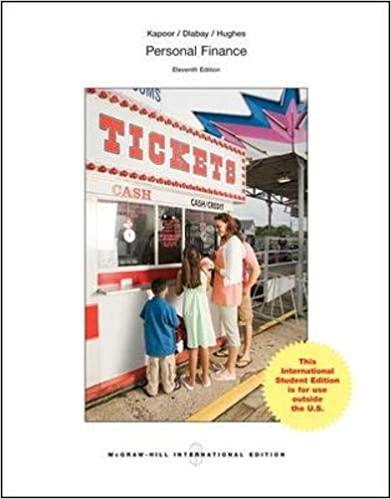Question
Balance Sheet 2015 2016 2017 Assets Cash 807,000 628,000 612,000 Accounts Receivables 2,582,000 2,896,000 4,605,000 Inventories 2,870,000 5,181,000 7,319,000 Total Current Assets 6,259,000 8,705,000 12,536,000
| Balance Sheet | 2015 | 2016 | 2017 | |
| Assets | ||||
| Cash | 807,000 | 628,000 | 612,000 | |
| Accounts Receivables | 2,582,000 | 2,896,000 | 4,605,000 | |
| Inventories | 2,870,000 | 5,181,000 | 7,319,000 | |
| Total Current Assets | 6,259,000 | 8,705,000 | 12,536,000 | |
| Net Fixed Assets | 2,216,000 | 2,423,000 | 5,538,000 | |
| Total Assets | 8,475,000 | 11,128,000 | 15,074,000 | |
| Liabilities and Equity | ||||
| Accounts Payable | 961,000 | 1,648,000 | 3,137,000 | |
| Notes Payable | 400,000 | 800,000 | 2,860,000 | |
| Accruals | 440,000 | 800,000 | 1,150,000 | |
| Total Current Liabilities | 1,801,000 | 3,248,000 | 7,147,000 | |
| Long Term Debt | 1,350,000 | 1,908,000 | 1,867,000 | |
| Common Stock | 3,650,000 | 3,650,000 | 3,650,000 | |
| Retained Earnings | 1,674,000 | 2,322,000 | 2,410,000 | |
| Total Equity | 5,324,000 | 5,972,000 | 6,060,000 | |
| Total Liabilities and Equity | 8,475,000 | 11,128,000 | 15,074,000 | |
| Income Statement | 2015 | 2016 | 2017 | |
| Sales | 26,820,000 | 28,966,000 | 30,703,000 | |
| Cost of Sales | 21,216,000 | 23,550,000 | 26,140,000 | |
| Gross Profit | 5,604,000 | 5,416,000 | 4,563,000 | |
| Operating Expenses | 2,574,000 | 3,225,000 | 3,866,000 | |
| Operating Profit | 3,030,000 | 2,191,000 | 697,000 | |
| Interest | 91,000 | 275,000 | 469,000 | |
| Earnings Before Taxes | 2,939,000 | 1,916,000 | 228,000 | |
| Taxes (48%) | 1,411,000 | 919,000 | 110,000 | |
| Net Income | 1,528,000 | 997,000 | 118,000 |
1)
a.
| Liquidity | 2015 | 2016 | 2017 | Average |
| Current Ratio | 3.475 | 2.68 | 1.754 | 2.5x |
| Quick Ratio | 1.882 | 1.085 | 0.73 | 1.0x |
| Asset Management | ||||
| Average Collection Period | 35.139 | 36.492 | 54.745 | 32.0 (days) |
| Inventory Turnover | 7.392 | 4.545 | 3.572 | 7.0x Fixed |
| Asset Turnover | 3.165 | 2.603 | 2.037 | 12 |
| Debt Management | ||||
| Total Debt to Total Assets | 0.372 | 0.463 | 0.598 | 50.00% |
| Times Interest Earned | 33.297 | 7.967 | 1.486 | 7.7x |
| Profitability | ||||
| Profit Margin | 0.057 | 0.034 | 0.004 | 2.90% |
| Return on Equity (ROE) | 0.287 | 0.167 | 0.019 | 17.50% |
ABC Company, a toy manufacturer, believes the coming holiday season (between Thanksgiving in late November and Christmas on the 25th of December) will be a very good one, expecting an increase of 20% in its sales. Outside economic analysts believe the effects of the recent recession are over. Consumer confidence is high. To meet that 20% increase, however, inventories must be built up so, to finance that expansion, ABC wants to borrow $1,000,000 from its bank.
You are the loan officer who must make the decision as to whether or not to give ABC the money. You are going to prepare ratios for 3 years, the Cash Conversion Cycle for the same period and operating cash flow for the years for which you have figures.
Review the Balance Sheets and Income Statements for ABC over the 3 years and answer the following questions (20 points each)
2) The Cash Conversion Cycle is an important management tool. a) Define the operating cycle. What does it tell us? b) Define the cash conversion cycle. What does it tell us? c) Calculate ABCs operating and cash conversion cycles for 3 years.
What do they tell you about ABCs cash management policies?
3) Operating Cash Flow is the first of the 3 parts to the Statement of Cash Flows.
a) Define operating cash flow. What does it tell us? b) Calculate ABCs operating cash flows for those years for which figures
are available. c) Does your analysis of ABCs operating cash flows change your conclusions listed in 1) and 2) above?
Please answer the questions in bold!!!
Step by Step Solution
There are 3 Steps involved in it
Step: 1

Get Instant Access to Expert-Tailored Solutions
See step-by-step solutions with expert insights and AI powered tools for academic success
Step: 2

Step: 3

Ace Your Homework with AI
Get the answers you need in no time with our AI-driven, step-by-step assistance
Get Started


